
The Bragg House is a historic house in rural Ouachita County, Arkansas. It is a two-story Greek Revival house located about 4 miles (6.4 km) west of Camden, the county seat, on United States Route 278. The house is basically rectangular in plan, with a hip roof. Its main entrance is sheltered by a two-story temple-style portico, with four columns topped with Doric capitals, and a turned-baluster railing on the second floor. Peter Newcomb Bragg began construction of the house in 1842, but did not complete it until 1850. The house was built out of virgin lumber sawn on Bragg's sawmill by his slaves; it remains in the hands of Bragg's descendants.
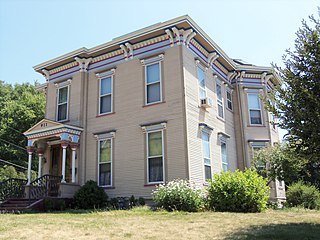
The James E. Lindsay House is a historic building located on the east side of Davenport, Iowa, United States. It has been listed on the National Register of Historic Places since 1984.
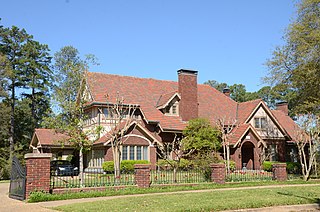
The Charles H. Murphy Sr. House in El Dorado, Arkansas, was built in 1925. The 2-1/2 story house was designed in Tudor Revival style by architect Charles L. Thompson, and built in 1925–26, during El Dorado's oil boom years. Charles Murphy was a major landowner, originally in the lumber business, who benefitted greatly from the oil boom due to the increased value of local real estate. He founded the predecessor company to Murphy Oil, which is still headquartered in El Dorado.
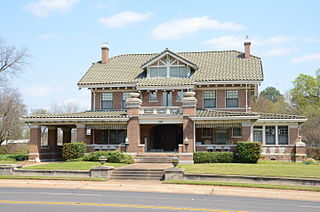
The Bottoms House is a historic house at 500 Hickory Street in Texarkana, Arkansas. It is a 2-1/2 story buff brick structure with a jerkin-headed gable roof and a large gable dormer, set on a raised corner. It was designed by Bayard Witt, a Texarkana architect, and built in 1910 for George Bottoms, one of area's principal lumber businessmen. The house's basic design follows the Prairie School, with broad lines exemplified by its sweeping single-story porch, although the half-timbered detailing found inside is Tudor in inspiration, and other details, such as colored windows and exposed rafters, are Craftsman in orientation.
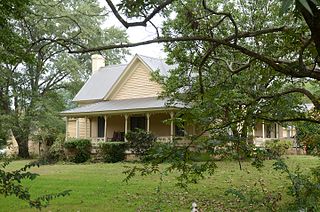
The Womack–Parker House is a historic house off Arkansas Highway 4 in Nashville, Arkansas. The house is notable for its age, its association with one of Nashville's leading businessmen, and for its distinctive architecture. The house is a single block of wood frame construction with a central hall plan. It has porches with decorative jigsaw woodwork on three sides. Its construction date is uncertain, but it was purchased in 1878 by David Womack and extensively altered. Womack arrived in Howard County in 1849, and operated a highly successful array of businesses, including a lumber mill, and a cotton gin. The property on which the house stands also includes a variety of 19th-century log structures.
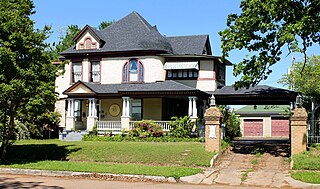
The J. K. Wadley House is a historic house located at 618 Pecan Street in Texarkana, Arkansas.

The Alvah Horace Whitmarsh House is a historic house at 711 Pecan Street in Texarkana, Arkansas. This 2-1/2 story wood frame structure is one of the city's finest Queen Anne Victorians, located in a neighborhood that was fashionable at the turn of the 20th century. The house has an elaborately decorated front porch and a three-story hexagonal tower, capped by a pointed roof, at its northeast corner. The house was built in 1894 for Alvah Whitmarsh, a manager at the local Buchanan Lumber Company and a local leader in civic affairs.
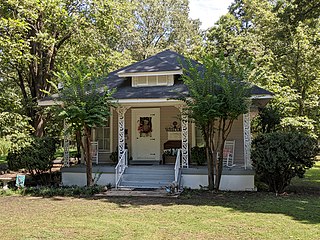
The Chris Tompkins House is a historic house at 144 South Oak Drive in Burdette, Arkansas. It is a single story wood frame structure, with a broadly overhanging hip roof and dormer. A porch with wrought iron railing extends across the front of the house, and a carport, added in 1938, is on the north side. The house was built in 1903 by the Three States Lumber Company, a major lumber operator in the early decades of the 20th century in Mississippi County, as a residence for mid-level managers. Burdette was essentially a company town at the time, and this is one of two houses from the period to survive.

The Poinsett Lumber and Manufacturing Company Manager's House, also known locally as the Singer Mansion, is a historic house at 512 Poinsett Avenue in Trumann, Arkansas. It is a single-story structure, with a varied roof line, and multiple exterior sheathing materials, including brick and stucco with false half-timbering typical of the Tudor Revival style, and recently applied modern siding. The house was designed by Edwin B. Phillips and built in 1935 for the Poinsett Lumber Company to house its senior on-site manager. It is, despite the modern siding, the only Tudor Revival building in Trumann, and the only surviving residence associated with the Poinsett Lumber Company, a major area employer in the first half of the 20th century.

The Waddle House is a historic house on South Erwin Street in Success, Arkansas. It is a two-story wood frame L-shaped structure, with a hip roof that has large gable sections. A single-story porch wraps around two sides of the house. It was built in 1909, when the town was at its economic height due to the success lumber industry. It was built by Dr. M. V. B. Waddle, one of the first doctors to serve in the area, and was one of the finest houses in the town at the time of its construction.
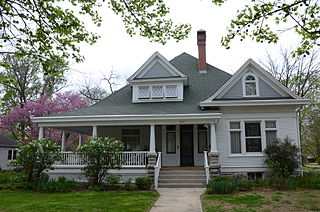
The Blackburn House is a historic house at 220 North Fourth Street in Rogers, Arkansas. It is a 1-1/2 story wood frame structure, set on a stone foundation, with a busy roofline typical of Late Victorian styling, but with more stylistically Classical Revival features, such as turned columns supporting its wraparound porch. The house was built in 1907 by J. A. C. Blackburn, a lumber baron who controlled much of the timber industry in northwestern Arkansas. Blackburn built the house as a showcase for his wood products.

Quigley's Castle is a historic house museum and garden at 274 Quigley Castle Road, off Arkansas Highway 23 south of Eureka Springs, Arkansas, and is one of the most unusual houses in northwestern Arkansas. The house was designed by Elise Quigley and built in 1943 by Albert Quigley and a neighbor, using lumber from the property. The exterior of the house is decorated with the collection of rocks Elise Quigley had accumulated since childhood. The house was specifically designed by Quigley to accommodate a two-story space for tropical plants. Over the years Elise Quigley's gardens expanded to take over much of the property. In 1950 the family began charging admission to tour the home, a practice that continues today.

The Ferguson-Calderara House is a historic house at 214 North 14th Street in Fort Smith, Arkansas. It is a roughly rectangular 2-1/2 story wood frame structure, with a high hip roof punctuated by large gables. A single-story hip-roofed porch, supported by round modified Ionic columns with a decorative wooden balustrade between, extends across the front and along one side. The front-facing gable has a Palladian window with diamond lights, and the left side of the second floor front facade has a former porch with decorative pilasters and carved arch moldings. The house was built in 1904 for A. L. Ferguson, owner of one of Fort Smith's largest lumber companies.

The W. C. Brown House is a historic house located at 2330 Central Avenue in Hot Springs, Arkansas. It is a large 21-room mansion, with a prominent location on one of the city's major thoroughfares.
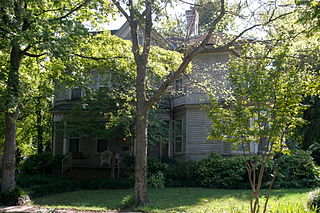
The Empie-Van Dyke House is a historic house at 403 Laurel Street in Newport, Arkansas. It is a two-story wood frame structure, with the asymmetrical massing typical of the Queen Anne style. It has two projecting sections, one at a corner that is topped by a pyramidal tower. Built in 1891, it was one of the first Queen Anne houses built in the city, and is one of its few older homes to survive with little alteration. It was built by William B. Empie, owner of local lumber-related businesses, and survived the town's great 1927 flood.

The Orth C. Galloway House is a historic house at 504 Park Street in Clarendon, Arkansas. It is a 2 1⁄2-story wood-frame structure, with Colonial Revival styling designed by George Franklin Barber. It was built in 1910 for Orth Galloway, owner of a local lumber mill. Barber's design is of a considerably higher style than was typically found in his pattern-book publications, which were widely used in the southern US. Its most prominent feature is its two-story Classical Revival entrance portico, supported by clustered Doric columns.
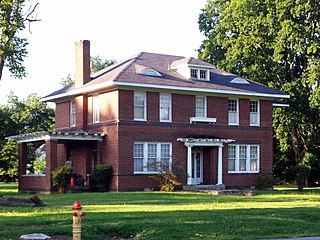
The Jefferies-Crabtree House is a historic house at 300 Jefferson Street in Clarendon, Arkansas. It is a two-story red brick structure, with a hip roof pierced by a central shed-roof dormer and a pair of eyebrow louvered attic vents. The front facade is symmetrically arranged, with tripled sash windows on either side of the center entrance, which is recessed and has a projecting narrow portico supported by slender round columns. The house was designed by Estes Mann whose practice was based in Memphis, Tennessee, and was built in 1923 for Alfred Jefferies, whose family owned mercantile and lumber businesses.

The Binks Hess House and Barn are a historic farm property in Marcella, Arkansas. Located just east of Arkansas Highway 14 on Partee Drive, it is a 1-1/2 story dogtrot house, with a side gable roof, weatherboard siding, and a stone pier foundation. A single-story porch, supported by square posts, stands in front of the open breezeway section, which is finished in flushboarding, at the center of the east-facing main facade. An ell extends to the rear. Behind the house stands the barn, built on a transverse crib plan with side shed-roof additions. Both house and barn were built about 1871 for Binks Hess, brother of Marcella's founder Thomas. The barn is believed to be the oldest in Stone County, and the first to use sawn lumber in its construction.
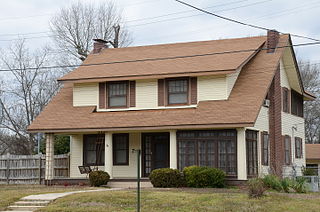
The Strauss House is a historic house at 528 East Page Street in Malvern, Arkansas. It is a 1-1/2 story wood frame structure, with a side gable roof, clapboard siding, and a brick foundation. Its front facade has a wide shed-roof dormer with extended eaves in the roof, and a recessed porch supported by Tuscan columns. Built in 1919, it was designed by the Arkansas firm of Thompson and Harding, and is a fine local variant of the Dutch Colonial Revival style.

The C.L. Sailor House is a historic house at Wilson and Wiley Streets in Bigelow, Arkansas. It is a 1-1/2 story wood frame structure, its walls a combination of brick and composition shingles, set on a stone foundation. Its dominant feature is a wraparound porch, supported by paneled posts set on brick piers. Built in 1917, it is a distinctive blend of Colonial Revival and Craftsman styling. C.L. Sailor, for whom it was built, was general manager of the Bayou Fourche Lumber Company, and owned two area newspapers.




















